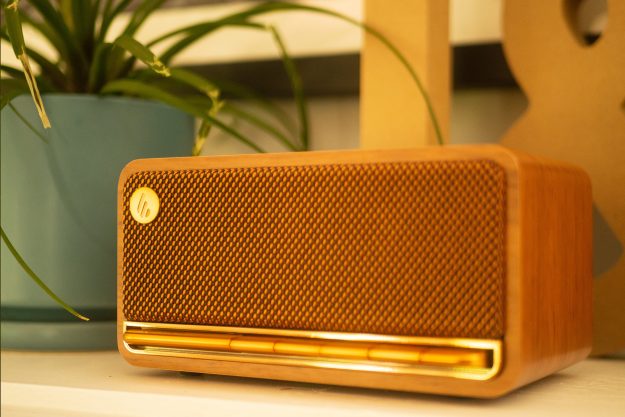“The HM-31 does one thing - and does it well.”
- Compact
- high quality HDMI switch; easy to use; excellent audio/video quality
- High price; limited to 3 HDMI outputs
Summary
A rapidly growing number of HDTVs and components use HDMI cables as the primary or optional connection point. The only trouble is that most HDTVs typically have a single or double HDMI input, instantly limiting the number of devices that can be connected at once. OPPO has the perfect solution to this HDMI limitation – their $99 USD “HM-31″ HDMI switch. Check out our review and the HM-31’s specs to see if it’s the right product for your home theater setup.
Features and Design
The OPPO HM-31 is a very compact, very precise device with a single purpose – connecting up to three HDMI sources to a single HDMI input on your HDTV.
The HM-31 uses the HMDI 1.3 spec and supports 720p, 1080i, 1080p, DeepColor and all common HDTV screen resolutions.
The HM-31 itself is 7.375″x4.5″x1.06” and it weighs only 9oz. It looks small in the hand, and even smaller next to an HDTV. The body is made of plastic and aluminum. While this may sound flimsy, the HM-31 feels very sturdy.
On the front of the HM-31, there are three indicator lights to show you which HDMI line is active, an infrared receiver, a power light and a manual button to switch between HMDI sources without using the remote control.
On the back of the HM-31, there’s a 5V DC power plug, an RS-232C port for RS-232C remote controls, an external infrared sensor input, a single HDMI output and three HDMI inputs.
On the bottom of the HM-31 there are three mounting hooks so the HM-31 can be mounted on a wall or against some other surface.
The included remote control is roughly the same thickness as the new iPod touch, though it’s shorter and narrower. The remote only has four buttons -rotate, 1, 2 and 3. Rotate is used to switch to the next HDMI source. The 1-3 buttons relate to the three HDMI inputs. The remote uses a replaceable 3V Lithium button battery.
Included with the OPPO HM-31 are four thin foam pads to protect the surfaces the HM-31 is placed upon, a synthetic fiber pouch for the HM-31, a handy instruction booklet and the power adapter.
The HM-31 uses only 5 watts of power, so you can leave it on without doing too much damage to your electric bill. To be environmentally responsible, turn it off when not in use.
The Oppo HM-31 is attractive looking and solid feeling
Setup and Use
Setting up the HM-31 is quick and easy. Connect your HDTV to the HM-31 by running an HDMI cable between one of your HDTV’s HDMI inputs to the HM-31’s HDMI output port. Connect your components (DVD plater, cable box, Apple TV, XBOX, etc.) directly into the HM-31’s three HDMI input ports. Connect the power adapter to a wall outlet and the DC end into the HM-31 power jack. The HM-31 will instantly turn on and will be ready to switch HDMI sources.
Turn on your TV and select the HDMI input that the HM-31 is connected to. With all your components turned on, one of the three HDMI sources will be on the screen of your HDTV. Use the HM-31 remote or the button on the front of the HM-31 to cycle through the three HDMI sources.
Note that when you use the HM-31 remote, the HM-31 needs to be in sight of the remote. The remote is infrared and will not go through components or walls. If you want to keep the HM-31 out of sight, you can do so by connecting an RS-232C remote adapter or an IR remote extender.
Once your components are connected and turned on, the HM-31 will show red lights on the front panel This is normal. A red light means that an HDMI signal is ready on that port. A blue light means that an HDMI signal is active and that particular HMDI source has been selected. Blinking blue means that a port/source has been selected but that no signal is detected by the HM-31.
When using the HM-31 for DVDs and HD-DVDs, the signal, picture and sound quality were all stunning. The picture from Apple TV, XBOX and PS3 is equally gorgeous. So long as the original file or audio/video signal is high quality, the HM-31 will bring that image across with no noticeable loss whatsoever. The source-to-display ratio is constant.
Conclusion
The OPPO HM-31 HDMI switch is a great little device for adding more HDMI devices than your HDTV can natively handle. The HM-31 is easy to use, takes up very little space and comes with a compact little remote. The HM-31 does one thing – and does it well. The $99 price point is the only factor that raised a few eyebrows. Other quality HDMI switches are available for less. If you’re familiar with OPPO, however, you’ll know that their products are high quality and usually worth the extra few dollars.
Pros:
• Compact, high quality HDMI switch
• Very easy to set up and use
• Excellent audio/video quality
• Supports 720p, 1080i, 1080p, etc.
Cons:
• High $99 price
• Limited to 3 HDMI outputs
Editors' Recommendations
- How LG’s OLED Art movement is inspiring and redefining the digital canvas
- Tivoli Audio’s Model Two Digital speaker abandons terrestrial radio
- Updating our Sony WF-1000XM5 review
- Samsung S95C OLED hands-on review: it’s time to get excited
- The absolute best tech we reviewed last month




